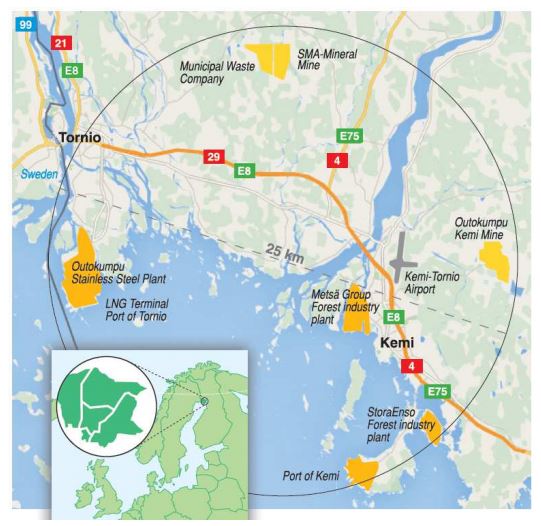The Kemi-Tornio region is situated in Northern Finland and comprises the cities of Kemi and Tornio, as well as the municipalities of Kiminmaa, Simo, and Tervola. The Kemi–Tornio industrial symbiosis involves companies exchanging industrial by-products (i.e. waste) with other companies that can use them as a substitute for raw materials. The collaboration includes actors from forestry, mining and steel industry companies, industrial service companies, research and educational organisations and intermediaries.
 Symbiotic activities
Symbiotic activities
The Kemi–Tornio region is important for industrial refinement and exports. It is responsible for 80% of Lapland’s industrial production and 7–8% of the total export value of Finland’s products. Companies in the region have been exchanging materials in a manner consistent with circular economic thinking for decades. A more systematic approach, and specific use of concepts such as “green growth”, “circular economy”, and “industrial symbiosis”, began in the early 2000s. Some examples of waste being used as raw materials include:
- Riffler waste (Metsä Fibre’s Kemi mill) is used as mulch in landscaping.
- Ash (StoraEnso Veitsiluoto mill) is used to fill open pits of a chrome mine after metal extraction has concluded (Outokumpu Kemi mine).
- Carbon monoxide surplus (Outokumpu ferrochrome factory) is used as fuel (SMA Mineral factory), replacing 17,000 m3 of oil annually.
Working together for sustainable natural resource management
Conditions for green growth have been favourable to the development of the Kemi–Tornio industrial symbiosis. Climate considerations are high on the agenda at the national, regional, and local levels, and sustainable natural resource use is seen as a key way to add value to Lapland’s exports. Regional strategies that have been instrumental in promoting green growth in the region include:
- ERDF 2007–2013 Programme for Lapland – Promotes business and innovation.
- Lapland’s Arctic Specialisation Programme – Promotes the sustainable utilisation of natural resources.
- ERDF 2014–2020 – Aims to strengthen Finland’s climate change and energy ambitions through the development of a new regional plan for climate and energy.
Sitra, the Finish innovation fund, along with private sector actors, for example, Digipolis Technology Park, have also been strong drivers of green growth in the region. Despite positive outcomes so far, there is a concern in the region that the full potential for green growth will not be realised without a long-term and systematic role for a competent and trustworthy intermediator to catalyse future activities.
Spotlinght on: Mapping industrial side streams
In 2014, Digipolis Technology Park in Kemi coordinated a project mapping industrial side streams in the Kemi–Tornio region. The aim of the project was to increase the utilisation of industrial waste as a substitute for raw materials by creating connections between companies in the region. It created a regional actor network through which to match companies whose raw material needs and waste were compatible. It also documented existing (unutilised) side streams with a view to paving the way for new business opportunities. Documentation of relevant side streams included recording their chemical and physical properties; analysis of the utilization grade of the side streams; and studies on markets, technology, and logistics related to the side streams. The project identified more than 1.3 million tonnes of annual by-products and waste streams (excluding the veinstone of mining activities). These have been documented in a databank of industrial side streams that will soon be opened up to companies and enterprises in the region.
Regional dimension
Sustaining local industries, while at the same time minimising their environmental impact, is vital to supporting the livelihood of communities in the Kemi–Tornio area in the long term (Watkins 2014). The industrial symbiosis in Kemi–Tornio also presents substantial opportunity for regional development. This is evident in two ways. First, knowledge of unutilised side streams lays the foundations for new and innovative business ideas. Secondly, the symbiosis itself can draw positive attention to the region as a unique example of a platform through which to create and strengthen an industrial ecosystem in Artic conditions (see figure: Kemi-Tornio industrial symbiosis).
Learn more…